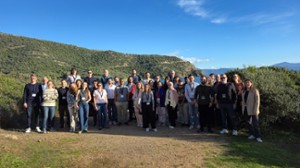on the November 28, 2025
Campus SophiaTech

PhD Thesis – Sparsity Optimization in Spiking Neural Networks for Event-Based Data Processing
Thesis submitted by Jonathan COURTOIS,
Laboratory of Electronics, Antennas and Telecommunications (LEAT),
in partial fulfillment of the requirements for the degree of Doctor in Electronics
at Université Côte d’Azur.
Supervised by: Benoit MIRAMOND, Professor, Université Côte d’Azur
Co-supervised by: Alain PEGATOQUET, Professor, Université Côte d’Azur
Abstract
This thesis investigates Spiking Neural Networks (SNNs) for event-based data processing in embedded applications where systems operate under strict energy constraints, with a particular focus on space applications.
While Formal Artificial Neural Networks (FNNs) have demonstrated remarkable capabilities for complex data processing, their high energy requirements often limit their use on such platforms. Neuromorphic computing, inspired by the architecture of the brain, represents a promising alternative. The human brain efficiently processes complex information with about 20 W and a computational density of 0.01 W/cm², compared to 50–100 W/cm² for conventional processors. SNNs emulate this efficiency through event-driven, spike-based communication, processing information sparsely and asynchronously. Combined with event-based cameras that transmit only significant brightness changes in the environment, these networks offer potential advantages for low-power image processing applications, with particularly interesting capabilities for space use cases.
This thesis develops a complete methodology for the design and evaluation of embedded SNNs on neuromorphic hardware. The main contribution is to assess the feasibility of complex tasks such as object detection and pose estimation for space applications using neuromorphic, event-based approaches — a research area that remains unexplored at this level of complexity. In light of this novelty, our work progresses methodically through all stages of SNN implementation.
We begin by defining a hardware-agnostic metric to evaluate the energy efficiency of SNNs compared to FNNs. The results show that SNNs can achieve a 6- to 8-fold reduction in energy consumption compared to equivalent FNNs while maintaining comparable accuracy, with memory access energy dominating the total consumption. This provides a crucial foundation for designing future solutions.
Building on this basis, we contribute to the extension of QUALIA, an open-source framework for designing, training, quantizing and deploying neural networks (FNNs and SNNs) on various platforms (CPU, microcontroller, FPGA). QUALIA bridges the gap between high-level neural network specifications and hardware implementations, supports PyTorch-based SNN development, and integrates SPLEAT, a configurable neuromorphic accelerator on FPGA. The toolchain is completed by QUALIABENCH, an automation solution that democratizes access to neuromorphic technologies by enabling systematic deployment and evaluation of networks on the target hardware without requiring in-depth hardware expertise.
Progressing from simple to more complex implementations, we push the limits of SNNs on neuromorphic hardware. The object detection solution deployed on the SPLEAT platform achieves 46% faster inference with a threefold improvement in energy efficiency compared to CPU-only execution, demonstrating the feasibility of implementing complex SNN architectures on reconfigurable platforms. We also investigate the feasibility of two methods for satellite pose estimation: direct event-based monocular 6D pose estimation and keypoint prediction for indirect pose estimation with a U-Net-type architecture.
These advanced applications demonstrate that the combination of SNNs and event-based sensors constitutes a viable approach for energy-efficient processing in constrained space environments, with potential applications in autonomous navigation, object detection and environmental monitoring.
Keywords: spiking neural networks, event camera, embedded systems, bio-inspiration, event-based data processing, hardware deployment, energy consumption, neuromorphic computing.

